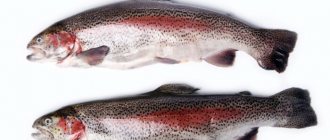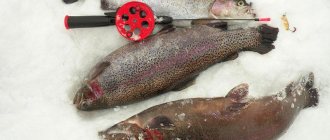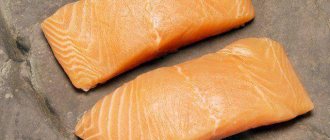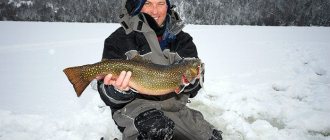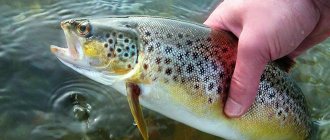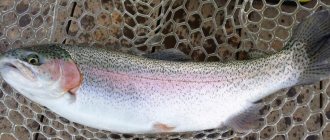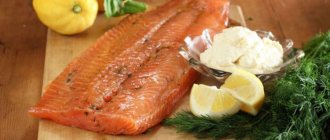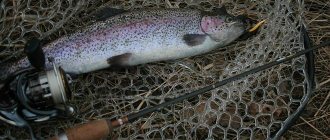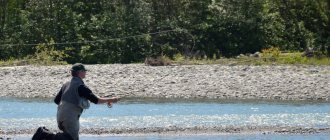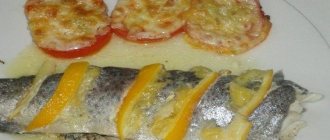The Republic of Karelia is a region that combines huge areas with a large number of reservoirs suitable for fishing. These are amazing places, because here you can find the shore of a reservoir where no one has ever set foot, but it is far from a fact that fish will be caught there. Underwater inhabitants are not stupid, so they are wary of fishermen’s gear and bait.
Despite the fact that most underwater inhabitants are wild, they are still wary of gear and are very scared when a fisherman approaches the water, so in order to catch a truly worthwhile trophy, you need to prepare in advance. Before you start preparing the equipment, you need to decide on the object of fishing, and based on this, prepare for fishing. Also, do not forget that fish are not caught in all bodies of water.
What kind of fish is found in the Republic of Karelia
Karelia is one of the rare places that has not been touched by industry and civilization. This is why trophy fish can be found in such pristine areas. Having gone fishing to Karelia for the first time, a tourist will not want to visit other places for this purpose. People from all over the country come here who want to relax not only their bodies, but also their souls, and at the same time spend time profitably. Local reservoirs are a great opportunity to hone your skills and test your luck. In the Republic of Karelia you can catch the following ichthyofauna:
- Grayling;
- Whitefish;
- vendace;
- Roach;
- Pike;
- Guster;
- Sinets;
- Bream;
- Ruff;
- Ide;
- Zander;
- Trout;
- Lake salmon;
- Burbot;
- Bleak;
- Perch.
Fishing in Karelia is not just part of the national culture of the people, but rather a way of life of the local population.
The whole life of a Karelian is in one way or another connected with fish, fishing and storing fish for the winter. To say that a Karelian simply goes fishing is to say nothing, since Karelians have several completely different types of fishing, with their own gear, goals and end result. Fishing in Karelia is more than fishing. Autumn fishing
Whitefish fishing begins around mid-September, when small whitefish, called in our area lehtisiika (“leaf whitefish”), begin to move on the lakes. This name contains the whole meaning of September whitefish fishing: it begins just during the leaf fall period. Whitefish at this time, of course, is of little use for storage; it is mainly used fresh and as lightly salted fish for the autumn period. But the real whitefish spawning takes place in October - November, along with cold weather, stormy winds, the first frosts and snowfalls. Fishing in November is hard and harsh work. But, nevertheless, it brings good results, because in two to three days a fisherman is able to prepare fish for the whole family for the whole winter.
Vendace is caught during the same period, it is also salted for the winter, but as a more delicate fish, vendace is not stored in salted form for so long - by February they try to eat all its reserves, since by the beginning of spring vendace completely loses its taste.
Often vendace has to be caught under the ice, since early frosts freeze the small lakes where this species lives at the height of the autumn spawning. It is characteristic that in small reservoirs of Karelia there are large vendace, and in large lakes, on the contrary, there are small ones.
Spring and summer
Specialized fishing begins much later, when the rivers open up and the ice begins to melt from the lakes. During this period, pike spawn, and local residents focus specifically on pike fishing. A little later, in May and at the very beginning of June, roach begins to spawn, which can also be caught in abundance. By the way, the famous Karelian kevätkala is the end result of spring fishing.
Throughout the summer, only the laziest fishermen set nets. In summer, you can easily catch the required amount of fish using an ordinary fishing rod, but among the Karelians it is not customary to catch summer fish as a reserve, when it is very difficult to preserve it. Therefore, they catch according to need: exactly as much as is needed to feed the family.
Since mid-August, avid Ukhta Karelian fishermen especially love donka fishing. Its essence lies in the fact that during this period large Kuyttovsky perch gathers in lake “pits” with a depth of 8 to 12 meters. This kind of fishing requires strong gear, because very large perches weighing more than a kilogram are caught on the bottom. They catch perches in the pits twice a day - early in the morning and in the evening. Pit fishing is very productive and always extremely emotional.
How to guess the time?
Every year, fishing periods begin at different times, which is determined by the weather conditions of the current season and the characteristics of the reservoirs. Local Karelians have a whole system of folk superstitions that guide fishing dates; many superstitions are passed down from generation to generation and are even kept secret within the family. For example, my father said that real fishing for lehtisiika begins when the hazel grouse willingly flies up to the decoy, and in the morning a birch leaf makes a light knock when falling (due to morning frosts, the leaves become hard). We caught vendace on a small lake; a sign when to start catching it was the appearance of the first black duck on this lake. “Konsa tulou musta sorsa,” that ’s what my father said. There is no witchcraft or mysticism in this, it’s just that the migration route of sea ducks, which have a characteristic black color, passes through this lake. And the time of migration of the black duck exactly coincides with the time of the beginning of vendace spawning.
Fishermen's huts
Since the tradition of fishing has the appearance of a folk craft in our country, the unspoken rules of behavior when fishing have the status of unwritten laws of life among the people. Unfortunately, current legislation limits the construction of coastal forest fishing huts, and there were times when they were abundant along the banks of all reservoirs of the Kalevala region. Such huts in Kalevala are more often called kämppä rather than mökki. As a rule, also adding the name of the owner of the hut: Kapasenkamppä, Jakkolankämppä, Sergeevinkämppä. However, in these unwritten forest laws, the one who built it was considered the owner of the hut only nominally. He was like that only while fishing. The rest of the time, the hut could be used by anyone who found it unoccupied on the shore. It was also considered a rule to offer a free place in the hut if two fishermen were fishing at the same time. Often the owner of the hut himself shares the place with other fishermen, and this is considered a good rule of hospitality among North Karelians.
Fishing signs
Local Karelians also have funny signs that must be observed when fishing.
You can’t spit in the water and swear in a boat - you’ll definitely call out the wind. Be sure to spit three times on the puikkari - nets or hooks - before you release them into the water. On the contrary, the one who sits on the oars and rows crookedly while setting the nets should swear more often, louder and stronger, this is a sure sign of fishing success. You cannot take fish or any fish product with you on a fishing trip - you won’t have any luck. The first fish caught, even if it is very small, is not thrown overboard - so as not to warn everyone else. On the contrary, it is customary to release the rest of the caught small fish so that it calls for larger fish. Some of these signs are, of course, international, but in local conditions they always have their own colorful nuance.
The material uses the author's photographs of Vitaly NIKULIN (Voknavolok village), Nadezhda VASILYEVA (Kalevala village).
Map of fishing spots
Urozero is an excellent reservoir for those who prefer to catch bleak. There is a lot of this fish here, but the only frequent problems are caused by ruffs, which bite on almost everything here. No less interesting species of fish in the reservoir can be found perch, pike, burbot and roach.
Ukshezero is a very interesting body of water in the republic, where fishermen can delight themselves with delicious burbot, but it is important to choose the right gear and bait for it. Vendace and whitefish are quite rare here, but especially lucky and experienced fishermen manage to catch them. In addition to the classic and familiar fish, the catches of local fishermen include perch, roach, pike and medium-sized bream.
Konchozero is also a rather interesting place for fishing, but you can rarely meet visitors here, but local fishermen often operate here with spinning rods. Their catches often include beautiful whitefish, medium-sized perch and medium-sized pike. Fans of float fishing often catch large roach on the shores of the lake.
Free fishing spots in the Republic of Karelia
Lake Onega is one of the largest bodies of water not only in the republic, but also in the country as a whole. Basically, fishermen from all over the world come to catch the legendary predator - lake salmon, which is almost impossible to find in other regions. Also, in this reservoir, trout can be a not rare trophy, which even local boats come to catch.
But you can also find classic fish here. You can often meet fishermen on the shores of a reservoir whose goal is to catch bream or roach. Well, from a boat, armed with spinning equipment, they often catch perch, pike perch and large pike in the water area.
The legendary and one of the largest lakes, Syamozero, which is located near Pakhta, Syapsi and other regions, constantly attracts fishermen to its shores. There is simply a huge amount of fish in this reservoir, among which interesting ones can be noted - whitefish, vendace and grayling. Fans of spin fishing try their luck in the pond in search of pike, pike perch, ide and chub.
Well, for those who prefer to sit on the shore with a fishing rod or feeder rod, there is an option to try their luck in catching roach, bream, sinew or silver bream. A float with a worm attached to a hook in this lake very often catches a ruff.
Fish of Karelian lakes
There are over 60 thousand lakes on the territory of the republic, only one third of them are wastewater, the rest have no flow.
Those that have flow are combined into a lake-river system, which has a positive effect on the inhabitants of these reservoirs. What kind of fish is found in Karelia? Object category (river, mountain system, forest, etc.): fish. Place: Republic of Karelia. Additionally: a complete description of all fish species in Karelia can be found in the book by Yu.V. Kostylev “Fauna of Karelia: fish”.
Fish in Karelia Edit
Population of Karelian reservoirs, according to the instructions of the author of the book “Animal World of Karelia: Fishes” Yu.V. Kostylev, occurred both due to the fauna of the Baltic Sea basin and due to the fauna of the White Sea. Also, the formation of ichthyofauna, according to the researcher, could have occurred from the Volga river system, presumably in the early post-glacial period. The author of the book points out that the lump resources of Karelian reservoirs are small, which is due to their northern location.
According to various sources, the species diversity of Karelian fish is about 70 species, of which only a third is of commercial importance1. Among these species the following families can be distinguished:
1) Salmon are the most valuable from the point of view of thought, they live in both fresh and salt waters, but reproduce only in freshwater reservoirs. Among them there are rare Atlantic sturgeon or lake trout, as well as the more common whitefish and vendace; it is one of the main commercial fish of the region. In Karelia, by the way, in addition to the European vendace, there is also a special subspecies of vendace – the White Sea vendace.
Lake trout (trout)4
2) Grayling – the brightly colored grayling with its high dorsal fin is easy to recognize. In Karelia, grayling is most common in Lakes Ladoga and Onega, as well as in Pyaozero.
3) Smelt - the family is represented by European smelt, White Sea smelt, and also capelin. There are two forms of smelt - large and small; these are schooling fish that feed on bottom crustaceans, but can also be predatory.
4) Herrings - in Karelia they are represented by only one species with two subspecies - Atlantic and White Sea herring.
White Sea herring5
5) Pike – pike can be called almost the most common inhabitant of Karelian waters. It lives everywhere, is easily recognizable, is a predator by nature, and does not disdain its own young. Pike is the heroine not only of the famous Russian fairy tale about Emelya, but also of the Karelian-Finnish epic “Kalevala”. It was from a huge pike, the “river dog”, that Elder Väinämöinen made his kantele.
6) Cyprinidae - here we can distinguish bream, which is also quite often caught by fishermen, and roach - the most common after perch; interestingly, it can feed on aquatic plants.
5) Perch - Karelian waters are home to species of this family such as perch and ruffe, which are found everywhere, as well as pike perch - the most valuable fish among perch.
Perch, pike, roach, burbot, and ruffe are widespread in the republic. You can also often find vendace and whitefish, but salmon or grayling are much less common2. The White Sea will delight the fisherman with herring, navaga, smelt, cod, flounder, salmon and trout. The Red Book of Karelia (2007 edition) contains 17 species of fish, including Atlantic sturgeon, sterlet, freshwater salmon, lake and brook trout, nelma, chub, rudd, catfish and others3.
Fishing ban
Amateur and sport fishing is prohibited in water bodies of fishery importance or parts thereof located on the territory of the Republic of Karelia:
- in the Keret River - from May 1 to October 31;
- in the rivers Elet, Vonga, Gridinka, Kuzema, Pongoma, Suma, Kalga, Sigreka, Kem from the mouth to the dam of the Putkinskaya hydroelectric power station, Vyg from the mouth to the dam of the Belomorskaya hydroelectric power station, in the rivers Pista, Vozhma, Pulonga, Petroyoki, Kamennaya, Vincha, Bolshaya ( Shattajoki, Shapka), Luzhma, Yangozerka, as well as in front of the mouths of these rivers at a distance of less than 1 km and in both directions from the mouths and at the same distance deep into the sea/lake in the period from June 1 to July 15.
- This prohibition also applies to channel lakes through which rivers flow;
- in lakes Varatskoye and Zabornoe, fishing is prohibited from April 20 to November 30;
- in lakes Pongoma and Vokshozero (basin of the Pongoma River) production (catch) from October 1 to October 31;
- in lakes Upper Neris and Lower Neris, lakes Paanajärvi, Salkäjärvi and Iso-Nieriyaisjärvi. On Lake Paanajärvi, fishing (catch) with hand-held fishing (catch) gear with a total number of single hooks of no more than 10 on a citizen’s fishing (catch) gear is allowed - from May 15 to October 31;
- in the Shuya rivers (from the mouth, including Lake Logmozero, to Lake Shotozero) with the Syapsya tributary - from April 25 to July 31;
